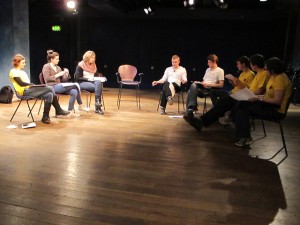
I used to do a ton of theatre as a kid. I had good directors. I had not-so-good directors. But when I looked in the mirror, what I always saw was one of the actors. Well, my pastor drafted me to direct my new Christmas Play. Yikes!
What am I going to do at my first rehearsal?
Last week I shared the first installment of my “Director’s Journal” — all about the lovely work my pastor did in the background, casting, organizing, and scheduling to make everything work smoothly.
Here’s the second post for any of you who also face directing your first Christmas play.
First Rehearsal
1. Introductions
The day came. We gathered for our first rehearsal. I put everyone in a circle. I opened in prayer, asking God to help us and the congregation live into this biblical story.
And I prayed especially that God would help this play be play. The whole thing should be fun, not a duty or a drag.
I briefly shared the concept: Christmas Play takes all the Gospel passages on the coming of Jesus, from Matthew, Luke, and John, and weaves them into one story. It invites us into the real meaning of Christmas, bypassing all our culture’s excesses.
I encouraged them to spend time with the words they would be speaking, taking it as an opportunity to meditate on the biblical text.
2. First Read-Through
The main task of a first rehearsal is to simply read through the text from start to finish, hearing it as a whole story in our own voices.
Before we started I gave one bit of direction:
Don’t pause between lines. As the last word of the line before your own is being spoken, start saying your line.
That is crucial to keeping a play from dragging.
There are times when a pause is needed to convey feeling and meaning. But if there is a pause before every line, all the good pauses become meaningless.
The first reading took about 20 minutes. Actual run time will probably be a smidge longer than that.
I have to say it was totally cool to hear the play in human voices. I have spent months with these words in my head, but now the meaning of every line got processed through other people’s minds and voices. That adds all kinds of dimensions to the story.
3. Notes
We took a few minutes for questions.
It wasn’t the time to talk acting details for particular parts. Nobody even knew where they would be standing.
Still the first read-through is a great time to begin to think like actors. I gave just one initial note:
As you read each line, and as you go over the play at home, keep asking yourself, “What does this character feel?” And then ask yourself, “What does this character want?”
Those are the simple questions behind the stereotypical actor question,
What’s my motivation?
That is all I said. I’ll surely come back to it as time goes on. I think this is what changes reading into acting.
They need to know the words, of course, but they also need figure out the feelings and desires that prompt those words.
Each actor’s line is part of a story. The overall story is driven by the feelings and desires of the characters as they face the situations the story puts them in.
Finding those feelings is each person’s part of telling a story together. Once they find those feelings and desires they will naturally communicate them to the audience.
4. Second Read-Through
I had to choose how to spend the rest of our time. I had planned to take each of the several lines that are spoken in unison and drill the group on them a bit.
Unison speech is pretty tricky. I may have been foolish to include it.
Actually, the group did quite well with the union bits in the first read through. I thought our time would be better spend just reading it through again in light of my little acting note.
Once more, with feeling!
as the saying goes.
It was subtly, but noticeably, better the second time through. They are doing great. I’m full of hope!
——
My Christmas Play is now available on Amazon! Woo hoo!
This post is part of a series. To go to the start, click here. To go to the next, click here.

Leave a Reply